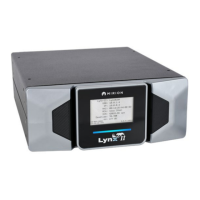Appendix C PUR/LTC Operation
168 Lynx II DSA User's Manual - 7096089
Live Time Correction With a Live Source
To compensate for events rejected due to pileup and processing time, a system dead time
is derived by the live-time correction function. The dead time signal controls the MCA
“Live-Time” clock which extends the acquisition time by the appropriate amount.
The accuracy of the Live Time Correction (LTC) deployed on both traditional analog
electronics and the Lynx II is dependent on the operation of the Fast Discriminator (fast
channel) and the pulse evolution time or dead time of the shaped signal (slow channel). In
the case of the Lynx II, the slow channel is the digital filtered trapezoid signal. Accurate
Live Time Correction is obtained when the energy threshold and dynamic range of the fast
channel and slow channel are the same. In practice, however, the energy threshold of the
fast channel is forced to be much higher compared to the slow channel. To obtain a good
pulse pair or timing resolution, the fast channel employs little or no noise filtering. As a
result, the signal-to-noise ratio is much worse, requiring a higher energy/noise threshold.
To optimize the LTC accuracy on traditional systems, the ADC LLD is adjusted or
optimized to normalize the energy threshold of the slow and fast channels. However, this
has the undesirable effect of affecting the spectral low energy cutoff.
On the Lynx II, the “LT Trim” function allows minor adjustment of the pulse evolution
time or dead time of the digital trapezoid signal to normalize the fast and slow channel
energy thresholds without affecting the spectral low energy cutoff threshold. LT Trim has
an adjustment value of 0 to 1000 and the default value is 500, which gives good Live Time
correction performance for most applications. In the steps that follow, Live Time
Correction accuracy is measured using the “two-source method” which monitors the area
of a reference spectral peak when subjected to varying rates of background counts. Typical
LTC performance (reference peak area variation) using the default LT Trim setting is
typically less than 3% for dead times of 50%. The discriminating user can improve
performance further, for the intended application, by calibrating the system using the
“Two-Source Method” and optimizing performance using LT Trim.
The following steps are designed to demonstrate and verify the effectiveness of the Live
Time Correction function. The verification/optimization process uses the “Two-Source
Method” which assumes that source “A” is
60
Co and source “B” is
137
Cs. The 1173.2 keV
peak of
60
Co will be used as a reference. The upper
60
Co peak, at 1332.5 keV, is not a
good choice because the sum peak of
137
Cs at 2 x 661.6 = 1323.2 keV would interfere with
the measurement.
1. Connect the Lynx II and set it up as described in System Connections for a Detector
on page 62.
2. Verify LTC is set ON.
3. Pole/Zero Compensation
The Pole/Zero was previously adjusted, and it is not necessary to do it again. If for
some reason readjustment is necessary, refer to Methods of Detector Matching on
page 173.
4. Set the MCA’s preset to 500 Live seconds.

